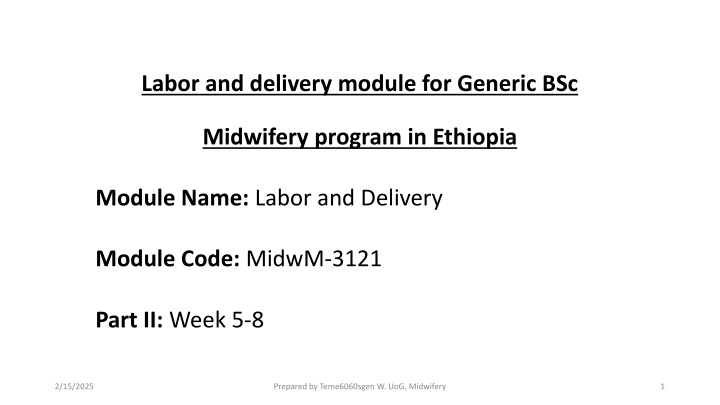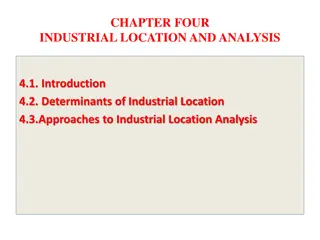Labor and Delivery Module for BSc Midwifery Program in Ethiopia
This module prepared for the Generic BSc Midwifery program in Ethiopia covers labor and delivery topics crucial for student learning outcomes, including abnormal patterns of labor, induction and augmentation techniques, mal-presentation management, and more. The presentation outlines various aspects of labor, including abnormal patterns, non-reassuring fetal heart rate, obstructed labor, and induction/augmentation strategies. Students are expected to achieve specified learning outcomes by the end of the module.
Download Presentation

Please find below an Image/Link to download the presentation.
The content on the website is provided AS IS for your information and personal use only. It may not be sold, licensed, or shared on other websites without obtaining consent from the author.If you encounter any issues during the download, it is possible that the publisher has removed the file from their server.
You are allowed to download the files provided on this website for personal or commercial use, subject to the condition that they are used lawfully. All files are the property of their respective owners.
The content on the website is provided AS IS for your information and personal use only. It may not be sold, licensed, or shared on other websites without obtaining consent from the author.
E N D
Presentation Transcript
Labor and delivery module for Generic BSc Midwifery program in Ethiopia Module Name: Labor and Delivery Module Code: MidwM-3121 Part II: Week 5-8 2/15/2025 Prepared by Teme6060sgen W. UoG, Midwifery 1
Learning outcomes Learning outcomes (1 of 3) This PowerPoint presentation is prepared based on national harmonized BSc in Midwifery curriculum in Ethiopia. It is ready for self learning to help BSc in Midwifery students acquire knowledge of labor and delivery. The material mainly addresses knowledge components and cognitive level skills of learning outcomes of contents in 5th week through 8th week of presentation in the curriculum. Learning outcomes are listed below and accordingly, students are expected to achieve them at the end of this presentation. 2/15/2025 Prepared by Teme6060sgen W. UoG, Midwifery 2
Learning outcomes (2 of 3) Learning outcomes (2 of 3) Differentiate abnormal patterns of labor in each stage (K ) Identify abnormal labour patterns in each stages of labor and initiate appropriate and timely intervention and/or referral (S) Identify indication for induction and augmentation of labor (K) Perform induction and augmentation of labor (S) Perform induction and augmentation of labor (S) Identify cephalopelvic disproportion(K) 2/15/2025 Prepared by Teme6060sgen W. UoG, Midwifery 3
Learning outcomes Learning outcomes (3 of 3) Manage or refer obstructed labor (S) Identify risks for obstetric fistula and provide care for women with obstetric fistula (K) Assess mal-presentation and malposition (K) Manage mal-presentation and malposition using appropriate manoeuvres (S) Distinguish complications of third stages of labor (K) Manage complications of third stages of labor (retained conceptus tissue, atonic uterus, tears) (S) 2/15/2025 Prepared by Teme6060sgen W. UoG, Midwifery 4
Presentation outline (1 of 2) Presentation outline (1 of 2) Abnormal labor o Prolonged latent phase o Protraction and arrest disorders o Precipitate labor Non-reassuring fetal heart rate pattern Obstructed labor Induction and Augmentation of labor Abnormalities of passage 2/15/2025 Prepared by Teme6060sgen W. UoG, Midwifery 5
Presentation outline (2 of 2) Presentation outline (2 of 2) Abnormalities of passenger oIntroduction, diagnosis and management of: (Malposition, Mal-presentation, Fetal Macrosomia, and Fetal malformation) Complications of third stages of labor oPost-partum hemorrhage Week 9 through 14 will be continued in part III presentation 2/15/2025 Prepared by Teme6060sgen W. UoG, Midwifery 6
Abnormal labor Abnormal labor Labor refers to: uterine contractions resulting in progressive dilation and effacement of the cervix accompanied by descent and expulsion of the fetus Abnormal labor, dystocia, and failure to progress protraction disorders (ie, slower than normal progress) or arrest disorders (ie, complete cessation of progress) 2/15/2025 Prepared by Teme6060sgen W. UoG, Midwifery 7
Dystocia Dystocia (1 of 3) (1 of 3) Dystocia is the consequence of four distinct abnormalities: that may exist singly or in combination: 1. Abnormalities of the expulsive forces uterine forces insufficiently inappropriately coordinated inadequate voluntary muscle effort during the second stage of labor 2/15/2025 Prepared by Teme6060sgen W. UoG, Midwifery 8
Dystocia Dystocia (2 of 3) (2 of 3) Dystocia is the consequence of four distinct abnormalities: 2. Abnormalities of presentation, position, or development of the fetus 3. Abnormalities of the maternal bony pelvis that is, pelvic contraction 4. Abnormalities of soft tissues of the reproductive tract that form an obstacle to fetal descent 2/15/2025 Prepared by Teme6060sgen W. UoG, Midwifery 9
Dystocia Dystocia (3 of 3) (3 of 3) these abnormalities can be mechanistically simplified into three categories: Abnormalities of the powers uterine contractility and maternal expulsive effort Abnormalities involving the passenger the fetus Abnormalities of the passage the pelvis 2/15/2025 Prepared by Teme6060sgen W. UoG, Midwifery 10
Abnormal labor Abnormal labor Friedman described four abnormal patterns of labor: prolonged latent phase protraction disorders (protracted active-phase dilatation and protracted descent) arrest disorders (arrest of dilatation, arrest of descent, and failure of descent) precipitate labor disorders 2/15/2025 Prepared by Teme6060sgen W. UoG, Midwifery 11
Abnormal labor Abnormal labor prolonged latent phase from the onset of regular uterine contractions to the beginning of the active phase of cervical dilatation (4 cm) latent phase averages 6.4 hours in nulliparas and 4.8 hours in multiparas abnormally prolonged more than 20 hours in nulliparas or 14 hours in multiparas 2/15/2025 Prepared by Teme6060sgen W. UoG, Midwifery 12
Abnormal labor Abnormal labor prolonged latent phase Causes: excessive sedation use of conduction or general anesthesia labor induction with an unfavorable cervix uterine dysfunction characterized by: weak, irregular, uncoordinated, and ineffective uterine contractions fetopelvic disproportion 2/15/2025 Prepared by Teme6060sgen W. UoG, Midwifery 13
Abnormal labor Abnormal labor prolonged latent phase Treatment options After 6 12 hours of rest with sedation and hydration, 85% of clients spontaneously enter the active phase of labor 10% clients will end up in false labor 5% clients with ineffective contraction will be manage by augmentation of labor 2/15/2025 Prepared by Teme6060sgen W. UoG, Midwifery 14
Abnormal labor Abnormal labor Protraction Disorders Protracted cervical dilatation in the active phase of labor and protracted descent of the fetus less than 1.2 cm/h in nulliparas or less than 1.5 cm/h in multiparas descent less than 1 cm/h in nulliparas or less than 2 cm/h in multiparas 2/15/2025 Prepared by Teme6060sgen W. UoG, Midwifery 15
Abnormal labor Abnormal labor Protraction Disorders second stage of labor Normal averages 20 minutes in parous women and 50 minutes in nulliparous Protracted, exceeds 2 hours in nulliparas or 1 hour in multiparas, or 3 and 2 hours, respectively, in the presence of conduction anesthesia 2/15/2025 Prepared by Teme6060sgen W. UoG, Midwifery 16
Abnormal labor Abnormal labor Protraction Disorders Causes Fetopelvic disproportion minor malpositions such as occiput posterior improperly administered conduction anesthesia excessive sedation pelvic tumors obstructing the birth canal 2/15/2025 Prepared by Teme6060sgen W. UoG, Midwifery 17
Abnormal labor Abnormal labor Protraction Disorders Treatment options depends on: the presence or absence of fetopelvic disproportion, the adequacy of uterine contractions, and the fetal status CPD: cesarean No CPD: oxytocin (augmentatation) 2/15/2025 Prepared by Teme6060sgen W. UoG, Midwifery 18
Abnormal labor Abnormal labor Arrest Disorders secondary arrest of dilatation, with no progressive cervical dilatation in the active phase of labor for 2 hours or more arrest of descent, with descent failing to progress for 1 hour or more Causes fetopelvic disproportion fetal malpositions inappropriately administered anesthesia excessive sedation 2/15/2025 Prepared by Teme6060sgen W. UoG, Midwifery 19
Abnormal labor Abnormal labor Arrest Disorders Treatment options thorough evaluation of fetopelvic relationships clinical pelvic examination for pelvic adequacy estimation of fetal weight Fetopelvic disproportion --- caesarean section No Fetopelvic disproportion --- augmentation 2/15/2025 Prepared by Teme6060sgen W. UoG, Midwifery 20
Abnormal labor Abnormal labor Precipitate Labor Disorders Precipitate labor delivery in less than 3 hours from onset of contractions Precipitate dilatation 5 cm or more per hour in a primipara or 10 cm or more per hour in a multipara May result from: extremely strong uterine contractions or low birth canal resistance 2/15/2025 Prepared by Teme6060sgen W. UoG, Midwifery 21
Abnormal labor Abnormal labor Precipitate Labor Disorders Maternal complications: rare if the cervix and birth canal are relaxed uterine rupture , lacerations of the birth canal postpartum hemorrhage Neonatal complications: Perinatal mortality decreased uteroplacental blood flow, possible intracranial hemorrhage, and risks associated with unattended delivery 2/15/2025 Prepared by Teme6060sgen W. UoG, Midwifery 22
Abnormal labor Abnormal labor Updated approach Diagnosis of Labor Abnormalities One practical system is: classify them as either protracted or arrested labor Protraction and arrest can occur anytime during labor The thresholds are defined according to the phase or stage of labor when they occur 2/15/2025 Prepared by Teme6060sgen W. UoG, Midwifery 23
Updated approach Zhang s studies Median and (95th percentile) hours for cervical dilation during labor by parity Cervical dilation (cm) Parity 0 Parity 1 Parity 2+ 3-4 1.8 (8.1) - - 4-5 1.3 (6.4) 1.4 (7.3) 1.4 (7.0) 5-6 0.8 (3.2) 0.8 (3.4) 0.8 (3.4) 6-7 0.6 (2.2) 0.5 (1.9) 0.5 (1.8) 7-8 0.5 (1.6) 0.4 (1.3) 0.4 (1.2) 8-9 0.5 (1.4) 0.3 (1.0) 0.3 (0.9) 9-10 0.5 (1.8) 0.3 (0.9) 0.3 (0.8) Second stage with epidural analgesia 1.1 (3.6) 0.4 (2.0) 0.3 (1.6) Second stage without epidural analgesia 0.6 (2.8) 0.2 (1.3) 0.1 (1.1) 2/15/2025 Prepared by Teme6060sgen W. UoG, Midwifery 24
Updated approach arrest disorder Zhang s studies suggest that: it is more reasonable to wait until cervical dilation ceases after reaching 5 to 6 cm dilation before establishing the diagnosis Cervical dilation 6 cm dilation and ruptured membranes with: No cervical change for 4 hours despite adequate contractions No cervical change for 6 hours with inadequate contractions 2/15/2025 Prepared by Teme6060sgen W. UoG, Midwifery 25
Updated approach arrest disorder Second stage No progress (descent or rotation) Nulliparous women: 4 hours with epidural anesthesia and 3 hours without epidural anesthesia Multiparous women: 3 hours with epidural anesthesia and 2 hours without epidural anesthesia 2/15/2025 Prepared by Teme6060sgen W. UoG, Midwifery 26
Obstructed Labor failure of descent of the fetus in the birth canal for mechanical reasons in spite of good uterine contractions Causes Cephalopelvic disproportion (CPD) Small or abnormal pelvis Fetal causes Malpresentations and malpositions Abnormalities of the reproductive tract 2/15/2025 Prepared by Teme6060sgen W. UoG, Midwifery 27
Obstructed Labor Complications Maternal and neonatal mortalities and morbidities Sepsis and septic shock Hemorrhage (APH, PPH), shock and anemia Urinary or/ and rectal fistula Ruptured uterus Nerve injury: drop foot Infertility following postpartum PID or hysterectomy Psychological trauma due to the painful labor experience, loss of the baby, fistula and social isolation 2/15/2025 Prepared by Teme6060sgen W. UoG, Midwifery 28
Obstructed Labor Diagnostic approach Requires a concerted team approach Rapid initial assessment early initiation of resuscitation close monitoring 2/15/2025 Prepared by Teme6060sgen W. UoG, Midwifery 29
Obstructed Labor Clinical evaluation and essential investigations History Duration of labor Change of labor pain characteristics to continue generalized abdominal pain generalized abdominal pain may be preceded by a sudden sever pain at the time of uterine rupture something gives away fetus is moving upwards 2/15/2025 Prepared by Teme6060sgen W. UoG, Midwifery 30
Obstructed Labor Clinical evaluation and essential investigations Physical Examination depend on the duration, complications, cause of the obstruction and gravidity Maternal exhaustion, anxiety, confusion, or unconsciousness Shock, Fever, Rapid respiratory rate Dehydration, Anemia, Decreased urinary output 2/15/2025 Prepared by Teme6060sgen W. UoG, Midwifery 31
Obstructed Labor Physical Examination Abdominal examination Fetal head/presenting part above the pelvic brim Abnormal/absent fetal heart rate Distended abdomen with tenderness and rebound tenderness Atonic uterus or tonic contractions and tightly molded around the fetus 2/15/2025 Prepared by Teme6060sgen W. UoG, Midwifery 32
Obstructed Labor Physical Examination Abdominal examination Bandl s ring --- late sign of obstructed labor The three tumor abdomen ---warning sign of an impending uterine rupture Ruptured uterus: Shock Abdominal distension/ free fluid Abnormal uterine contour Tender abdomen Easily palpable fetal parts Absent fetal movements and fetal heart sounds 2/15/2025 Prepared by Teme6060sgen W. UoG, Midwifery 33
Obstructed Labor 2/15/2025 Prepared by Teme6060sgen W. UoG, Midwifery 34
Obstructed Labor Physical Examination Vaginal examination Foul-smelling meconium and dry vagina Vaginal bleeding after rupture of the uterus tamponad effect Catheterization can be difficult---contain meconium or blood Edema of the vulva and cervix following prolonged pushing down and labor 2/15/2025 Prepared by Teme6060sgen W. UoG, Midwifery 35
Obstructed Labor Vaginal examination Depending on the cause of the obstruction, there may be: Large caput succedaneum in CPD Shoulder with or without prolapsed arm Brow Face presentation in mentoposterior 2/15/2025 Prepared by Teme6060sgen W. UoG, Midwifery 36
Obstructed Labor Document review ----partograph (what do you think the partograph looks like?) Investigations Occasional paracentesis preoperative assessment and evaluation: Hemoglobin/ Hct Blood group (ABO, Rh) Urine analysis Renal function tests (especially with decreased urine output) Blood culture and sensitivity Others test depending on individual clinical findings 2/15/2025 Prepared by Teme6060sgen W. UoG, Midwifery 37
Obstructed Labor (OL) Treatment Plan Resuscitation and monitoring of the life endangering conditions such as shock, sepsis Identifying the cause of OL and other complications and treating accordingly Sepsis: signs of infection, or the membranes have been ruptured for 12 hours or more Triple IV antibiotics (Ampicillin, Gentamycin, and Metronidazole) 2/15/2025 Prepared by Teme6060sgen W. UoG, Midwifery 38
Obstructed Labor Mode of Delivery in OL: Intact uterus with no imminent rupture --- CS vs operative vaginal delivery Imminent uterine rupture --- CS vs destructive for dead fetus Ruptured uterus Repair vs hysterectomy 2/15/2025 Prepared by Teme6060sgen W. UoG, Midwifery 39
Obstructed Labor Postoperative care and follow up Intensive resuscitation and monitoring should be continued till condition improves Blood transfusion Antibiotics IV till fever free for 2-3 days and continue coarse PO Investigation including blood and urine culture 2/15/2025 Prepared by Teme6060sgen W. UoG, Midwifery 40
Obstructed Labor Postoperative care and follow up Analgesics including pethidine Breast care for those with stillbirths or neonatal deaths Close monitoring to identify complications early Explain condition and counsel on future pregnancy Fistula care and follow-up 2/15/2025 Prepared by Teme6060sgen W. UoG, Midwifery 41
Induction and Augmentation of labor Induction and Augmentation of labor Induction of labor is the artificial stimulation of uterine contractions before the spontaneous onset of true labor at 28 or more weeks of gestation to achieve vaginal delivery Induction methods Surgical methods: ARM, ballooned catheter, laminaria Medical, pharmacological induction: Oxytocin, prostaglandins such as misopristone 2/15/2025 Prepared by Teme6060sgen W. UoG, Midwifery 42
Induction of Labor Induction of Labor Indications Preeclampsia, eclampsia, chronic hypertension Diabetes mellitus PROM Chorioamnionitis Abruptio placentae Post-term pregnancy Congenital abnormality 2/15/2025 Prepared by Teme6060sgen W. UoG, Midwifery 43
Induction of Labor Induction of Labor Indications continued IUFD Previous stillbirth Rh isoimmunization IUGR Contraindications Contraindications for labor or vaginal delivery Contraindications to oxytocin use, Contraindication for ARM 2/15/2025 Prepared by Teme6060sgen W. UoG, Midwifery 44
Induction of Labor Induction of Labor Prerequisites Valid indication for induction and termination No contraindication Elective induction What further prerequisites are needed for elective induction? 2/15/2025 Prepared by Teme6060sgen W. UoG, Midwifery 45
Induction of Labor Induction of Labor Prerequisites continued Elective induction lung maturity Lecithin/Sphingomyelin Ratio 2 Slide Agglutination Test for Phosphatidylglycerol > 0.5 mg/ml of amniotic fluid TDx Test (Surfactant Albumin Ratio) value of --70 vs 55 Lamellar Body Counts-- >30,000 to 55,000/ml is highly predictive of pulmonary maturity Bishop Score of favorable cervical condition 2/15/2025 Prepared by Teme6060sgen W. UoG, Midwifery 46
Bishop Score Score Dilation Effacement (%) Station Consistency Position 0 Closed 0-30 -3 Firm Posterior 1 1-2 40-50 -2 Medium Mid position 2 3-4 60-70 -1,0 Soft Anterior 3 5 80 +1, +2 2/15/2025 Prepared by Teme6060sgen W. UoG, Midwifery 47
Bishop Score Interpretation of the Bishop s score: Score 4: Unfavorable cervix is unlikely to yield for induction; Cervical ripening is needed for success with induction. Postpone induction for next week if possible or use cervical ripening and plan induction for next day. Score 5-8: Intermediate Score = 9: Favorable cervical condition and induction is likely to succeed. There is no need for cervical ripening. Induction using Oxytocin can be planned for next day 2/15/2025 Prepared by Teme6060sgen W. UoG, Midwifery 48
Bishop Score Methods of cervical ripening Vaginal misoprostol of 25 mcg is placed into the upper vagina and repeated after 6 hours. If there is no response after 2 dozes of 25 mcg, the dose is increased to 50 microgram every 6 hours for a total of 200 mcg. Stripping of membrane Folly catheter size16 or 18, inflated with 30 -50 ml of sterile saline 2/15/2025 Prepared by Teme6060sgen W. UoG, Midwifery 49
Induction of Labor Induction of Labor Protocol for induction and augmentation varies from hospital to hospital. In this presentation we will discuss based a 2010 updated management protocol on selected obstetrics topics and IMPAC 2017. However, practitioners have to obey a protocol of specific hospital in which they are assigned to practice. 2/15/2025 Prepared by Teme6060sgen W. UoG, Midwifery 50























